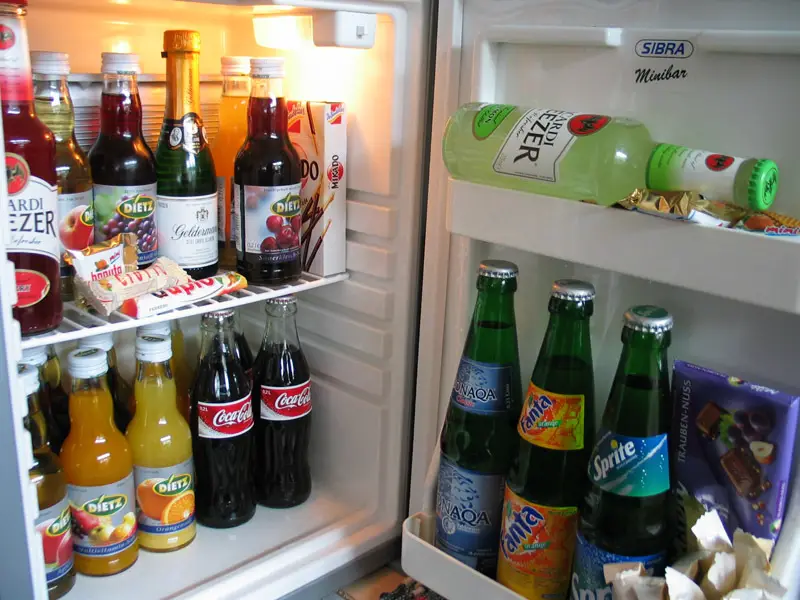Minibars are those tiny refrigerators that sit inside some hotel rooms. You may have been tempted at one point to grab something to drink or eat from one of these as a matter of convenience, but that was probably before you saw the prices for the items contained inside.
It would seem that paying $6 to $8 for a bottle of water is a little extreme, or that a $3 bag of M&M’s is a bit steep, but these are the prices that are usually seen in a hotel minibar. So why are the food and beverages in these minibars at hotels so expensive?
One answer may be too straightforward. Hotels charge these prices because they can. The items are conveniently located in the room, and you don’t have to put on a pair of pants and march outside to find a convenience store to get a drink or something to eat. Another answer is that the hotel wants travelers to go down to the hotel restaurant or bar to spend their money. The high prices could spur someone to opt for an alternative where the hotel could make more money.
Another reason for the inflated prices may have come about because of the time when companies were more lenient with expense accounts. A $4 bag of peanuts was written off on an expense report, and the company who had purchased the room would reimburse the traveler.
While hotels have made a profit off minibars in the past, things have changed. Hotels now say minibars are a loss leader. They cost the hotel money, even with the exorbitant prices.
One problem that hotels cite for losing money from minibars is from theft. People take the items or don’t end up paying for them even when billed. Others replace liquor with water or replace a snack with another cheaper item. Another problem comes from the cost to restock the items or replace the ones that have expired. Hotels must throw away items that have gone beyond their expiration date. This comes out as a loss.
The costs also add up when an employee has to check the fridges in every room every day to determine what was taken and what to put back. For example, in a hotel with 150 rooms, and with a staff member spending 5 minutes per room at best, it would take about 12.5 hours to restock or check every room. This doesn’t take into account the time it takes to go from room to room or any breaks during the day. Hotels have to staff enough employees to check all the minibars in all the rooms, and this becomes yet another expense for something that doesn’t end up making the hotel money and isn’t used that often by travelers.
Why don’t the hotels lower the price and sell more? They would probably have to hire even more staff members to tend to the minibars because of the time it would take to check and restock every room and to figure out what to bill the traveler. There would simply be more for the staff to do. Many hotels have opted for vending machines instead and have gotten rid of their minibars. Other chains have removed their minibars entirely, as many Hyatt and Hilton hotels have done.
Other hotels with minibars have tried to make them automated to cut down on the staff costs. The minibar automatically senses what has been taken, and a guest’s bill is charged. Some automated minibars give the guest 40 seconds to make a decision once an item has been removed. This means that the staff restocking the minibars know what has been purchased and can replace the items more easily. But automation has its problems too. Guests can be charged inappropriately for things they did not purchase, which leads to headaches for both the traveler and staff of the hotel.
Some hotel chains have made their minibars more exclusive and offer items that can’t be purchased in a convenience store to make the minibar more enticing. Some offer premium items that are specific to the area, such as craft beer from a local brewery. But the biggest sellers from a minibar happen to be the simplest. Bottled water is the number one purchase followed by Diet Coke, while on the snack end, travelers reach for a can of over-priced Pringles or M&M’s.
The minibar began in the early 1960s when a German company called Siegas introduced it to be used in high-end hotels. It found its first home in the Madison Hotel in Washington, DC in 1963. It spread globally when the Hong Kong Hilton became the first hotel to stock its minibars with liquor in 1974. The bars were included in all 840 rooms of the hotel, and it was such a hit for Hilton’s bottom line that they began to put them in all their hotels. From there, the minibar spread to other chains and other luxury hotels.
Sources: Independent UK, Economist, Daily Mail, Priceonomics, Wall Street Journal, The Atlantic



